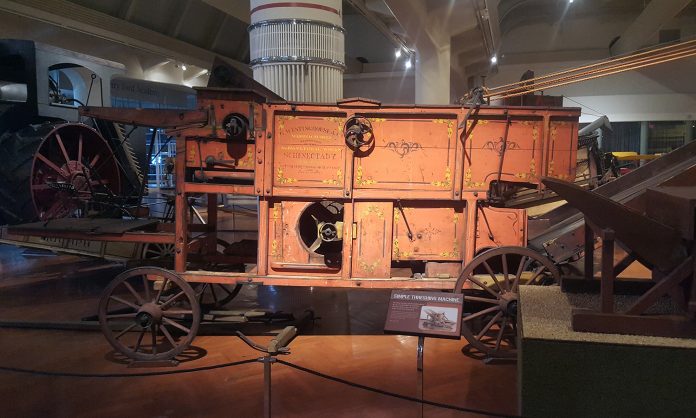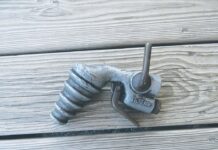
Several years ago, I edited some recipes that my grandmother possessed. They were recipes of a farming generation in the 1930s and 1940s, and I titled the collection Eat Like A Thresherman.
When I met with the publisher’s staff, the noun “thresherman” got their attention. They had no knowledge or experience with the significant event that occurred each summer in the farming communities.
It was obvious that I needed to explain if I wished to continue the title. So I did!
Greatest day of the year
Spelled “threshing” and pronounced “thrashing,” it was all the same. It was the greatest day of the year for farmers in the 1930s when life was slower, harder and more neighborly. It could come on any day of the week, but never — never — on Sunday.
The youngsters remember the noise, the bustle and the big machinery. The older children thought of this day as a fun day and the opportunity for new experiences. The men recall the sweaty work, as did the women preparing the food and dealing with the kitchen full of dirty dishes.
“Thrashin” day made all other days of the year possible.
The threshing process was followed with great interest by the farm family. After seeding the grain in the spring, following its growth in early summer, scanning the skies for a gentle rain and some years purchasing expensive harvesting implements, the family senses the significance of the threshing season.
It was the threshing machine that separated the grain from the straw, put the grain in the bin, put money in the bank that filled Christmas stockings and made birthdays worth remembering, and gave many farmers another year’s grace on the mortgage.
On the scheduled day that was dictated by the weather, you could feel the anticipation of the participants early in the morning.
This excitement started to mold in late June when grandfather cut and shocked his fields. First, it was rye, then wheat or spelts, and finally oats. The grain had ripened in that order.
The two-horse binder cut the grain and then tied it into sheaves with twine. Acting as field hands, we set the sheaves into shocks — butt down. A shock was about 10 sheaves with one on top broken open for a hood to shed water for the rest.
The grain would be allowed to stand in shocks for several days so as to sweat or dry out with the soft summer breeze. With the sun breathing down from high in the sky, the bundles of grain in the field resembled a bivouac of army tents.
Threshing time in Ohio usually started in mid-July and continued until all the area farmers had their grain secured in storage. It was an occasion that allowed neighbors, who had little or no time to visit because of spring or summer chores, to gather together.
They took the opportunity to tell tall tales, jokes, exchange recipes and, generally, gossip about the community.
Occasionally, a farmer might be disquieted because of the lateness of the steam engine reaching his farm to begin the harvest, but this attitude was short-lived because each individual farm entity depended on its neighbors for help. This being the case, good humor became the order of the day rather quickly.
Threshing train
When grandfather’s turn came to harvest, all ears turned in the direction the threshing outfit would be coming. We could hear it long before we could see it. With black smoke rising in the air and driven by two red back wheels, it was so tall a person could stand up in them.
Then, the 10 1/2 ton Huber Steam Engine finally came into view. It was a huge machine, all green and black metal with a firebox that ran the full length of the engine. Fired by coal, this Marion, Ohio, product, was the first engine most farmers had ever seen and traveled like a turtle at two and a half miles per hour.
When the long threshing train composed of the steam engine, the McCormick-Dearing separator or threshing machine, followed by the horse-drawn water wagon and coal tender finally arrived, gates were open to the field, livestock confined and water jugs were filled with cold spring water.
The separator was “set” or placed where the straw stack was to be located close to the barns. Then, the engineer owner of the equipment lined up the steam engine flywheel with the belt wheel of the separator very carefully. If the alignment was faulty, the belt would fall off as soon as it started to turn.
The engine was then watered and coaled and was soon producing power to propel the thrashing machine. The owner of the rig provided the personnel for the water wagon, the fireman to coal the engine, three workers for the separator and himself to run the engine. For this, he was paid 10-15 cents per bushel of grain separated.
By mid-morning, the July dew had burned off and men, women and children of the neighborhood came in horse-drawn wagons and low-powered, hard-riding trucks and automobiles; all came to trade work until the day’s task was finished.
Hard work
It would be a long, hard and warm workday. Grandfather didn’t care — the sun was shining, and it wasn’t raining on this year’s harvest.
With the engine and separator in place, the harvesting task began in the field where the men used pitchforks and muscle to load the shocks on the wagons to be carried to the separator. The wagons were loaded with the sheaves — butts out and the heads of the sheaves pointed into the center of the wagon, just barely touching.
It was a contest to see who could stack a wagon the highest and neatest. The official winner was the wagon that had its load stacked the straightest, like loaves of bread.
Despite the fact you worked in a full sun day, the fieldworker had a choice job. The work was relatively clean.
When the wagons arrived at the separator, the sheaves were pitched to one man who cut the twine and then shoved them to the second man who was the feeder. A feeder who knew his business would take the sheaves and shake them so they went gradually into the mouth of the separator.
A good feeder made the machine just hum, but an inexperienced feeder who didn’t know his stuff and didn’t shake the sheaves enough would make the separator groan, vibrate and shake. This was an easy way to provoke the engineer and ruin a good day if it happened too often.
When working properly, the threshing machine knocked the grain kernel from the stalks and then separated the kernels, straw and chaff. The grain fell into a measuring box and then was bagged. The gigantic fan blew the straw through the stack onto the growing pile of straw. Working on the separator was the dirtiest job of harvesting.
Once the day’s harvest began, the only work pause came for a quick drink of cold water or to eat the glorious dinner at noon. Dinner was proclaimed by one short blast of the engine’s steam whistle, which meant to stop the threshing process. Two long blasts declared work completed for the day.
The food
By the way, on the farm as a youngster, you ate dinner at noon and supper came after evening chores. Lunch was that little snack of sandwiches, pies and coffee that was fetched to the field in mid-morning or mid-afternoon to release your belt buckle from your spine or to take the rubber out of your knees.
When the engine’s whistle sounded dinner time, all hands stopped work, hayed and sheltered the horses from the mid-day sun and headed to the outside eating area.
On the way, they stopped at a makeshift washstand that consisted of a long primitive-style bench or several boards laid across sawhorses. Two or three men could wash at the same time using homemade lye soap or Lava soap at best, bucket after bucket of hot water washed the hands, forearms, neck and the head. The upper body was then rinsed with cold water. You toweled off the excess water, ran a comb through your hair, and you were ready to eat.
Grandmother’s farmhouse was big, but not large enough to handle an entire threshing crew. To accommodate the crew, wooden planks on sawhorses, covered with tablecloths, acted as the serving tables. Chairs and benches were placed out under the oak, elm and maple trees as places to eat and rest the body.
The clan would never use paper plates or store-bought bread for fear that they might be snickered at forever. Feeding the threshers was a theme of major dimensions.
Preparation began days in advance with the women planning their “award-winning” dishes. The annual event became a matter of pride, a competitive undertaking by the females, each attempting to set the best dish possible.
The threshing dinner was always the same: the roast beef was well done, platters of golden crisp fried chicken, last fall’s home hickory-smoked ham, snowy mountains of mashed potatoes capped by home churned butter, bowls of garden-fresh vegetables, boats of gravy, baskets of hot homemade breads and biscuits, and large brown earthenware crocks of baked beans lumpy with good pork.
The table was just about ready. To further please the palate of the hearty eaters, there were the “trimmins” — homemade pickles and relishes, fruit jams and jellies, corn-on-the-cob, carrots, fried onions, leaf lettuce and radishes extracted from the garden that all children hated to weed.
There were also tomatoes picked while still wet with night-time moisture and eggs gathered yesterday and deviled this morning. And standing tall at the end of the table was the huge blue granite pot of regular ground brawny coffee.
Serving was, by necessity, family-style, and food disappeared from the table like dew before a hot summer sun. Next, came the desserts: apple, raisin, pumpkin, peach, cherry and mince pies — all still warm to the taste. Cakes with rich icing and different flavors were also offered and sometimes homemade ice cream was served.
Following the dinner, there was a pause for rest, neighboring and a self-rolled Bull Durham cigarette. The whistle of the big engine would soon call the men back to the field.
Then, the women and children ate. Once again, all acknowledged they had set the best threshing table of the season.
When the sun began to lose its fire and to fade into the western sky and the moon rose on a curtain of blue sky, the cool breeze of evening brought a welcome relief to the men and women who had worked hard at harvesting this summer day.
That’s your history!












